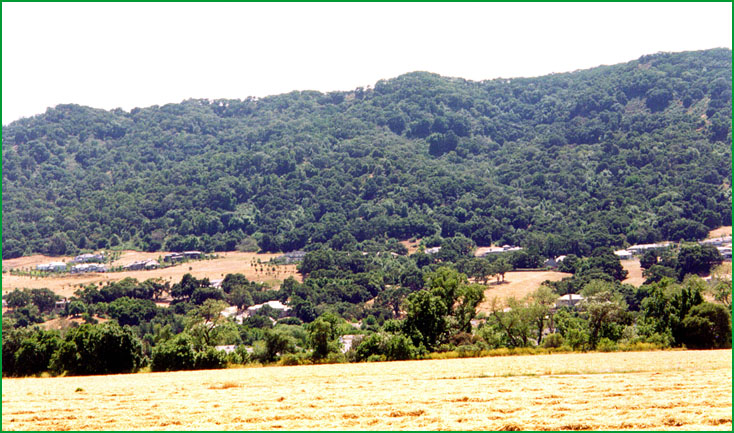 | East Bay Hills - Mount Diablo |
Union City area Ś Scott Miles |
http://www.fs.fed.us/r5/projects/ecoregions/261ac.htm
This subsection consists of Mt. Diablo of the Diablo Range and steep hills west of Mt. Diablo, between the Diablo Range and San Francisco Bay. The subsection is bounded on the southwest by the Hayward fault. It has a hot, subhumid climate. There is moderate marine influence on climate in the East Bay Hills, but that influence diminishes toward Mt. Diablo. MLRAs 14d and 15d.
Lithology and Stratigraphy. Cretaceous, Eocene, and Miocene marine and Pliocene nonmarine sedimentary rocks are predominant. These rocks and Pliocene volcanic rocks in the East Bay hills are folded and faulted. Rocks of the Franciscan Complex dominate the northwest side of Mt. Diablo. The floor of Diablo Valley is covered by late Quaternary or Recent alluvium.
Geomorphology. This is a subsection of northwest trending hills with subequal summits, rounded ridges, steep sides, and narrow canyons. Mt. Diablo and part of Diablo Valley are included in this subsection. The subsection elevation range is from sea-level to about 2000 feet in the East Bay Hills and up to 3849 feet on Mt. Diablo. Mass wasting and fluvial erosion are the main geomorphic processes.
Soils. The soils are predominantly Typic Argixerolls and Lithic Xerochrepts. Chromoxererts, Pelloxererts, and Calcic Haploxerolls are common in the foothills on the northwest side of Mt. Diablo. Typic Xerochrepts, Typic Chromoxererts, Typic and Chromic Pelloxererts, Mollic Haploxeralfs are common and Aquic Natrixeralfs are present on alluvial fans and floodplains of Diablo Valley and in narrow valleys in the East Bay Hills. Most of the soils are leached free of carbonates, but calcium carbonates have accumulated in some soils in the Mt. Diablo and Diablo Valley areas. The soil temperature regimes are thermic. Soil moisture regimes are xeric.
Vegetation. The predominant natural plant communities are Coast live oak series in the East Bay Hills, both Coast live oak series and Blue oak series on Mt. Diablo, and Valley oak on alluvial plains. Chamise series is extensive on shallow soils on Mt. Diablo, and the usual natural plant community on Vertisols is Needlegrass grasslands. California sagebrush series is present on shallow soils on south-facing slopes in the East Bay Hills.
Characteristic series by lifeform include:
Grasslands: California annual grassland series, Purple needlegrass series.
Shrublands: California sagebrush series, Chamise series, Chamise - bigberry manzanita series, Coyote brush series.
Forests and woodlands: Blue oak series, California bay series, California buckeye series, California sycamore series, Coast live oak series, Fremont cottonwood series, Hinds walnut stands, Mixed oak series, Valley oak series.
Climate. The mean annual precipitation is about 15 to 25 inches. It is practically all rain, except for some snow on Mt. Diablo. Mean annual temperature is about 54░ to 60░ F. The mean freeze-free period is about 225 to 275 days.
Surface Water. Runoff is rapid from the hills, but slow from the alluvial plains. All but the larger streams are dry through the summer. Natural lakes are absent.
